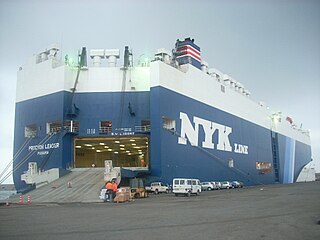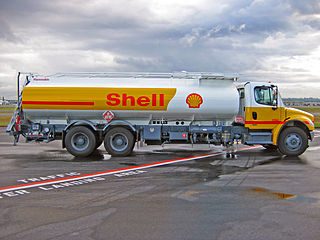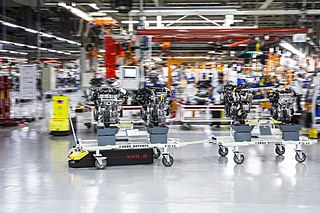History and products
KVAB's core business was trains, and they built all kinds of locomotives, trams, passenger cars, freight cars for both Swedish market and export.
In the mid-sixties, KVAB also produced small trucks, boats, parking decks and cars for road use. Tjorven was a small delivery van based on the DAF 44, Swedish Mail bought a lot of them for mail delivery.
Kalmar Terminal was a vehicle intended to be used for transporting goods in ports between ships and railway. One odd detail was that the door was located in the front. It had a V8 diesel engine, automatic gearbox, and semi-trailer coupling with built-in automatic air and electric connections. At forklift was mounted at the rear, so the truck driver could load and unload goods from the trailer.

A truck or lorry is a motor vehicle designed to transport freight, carry specialized payloads, or perform other utilitarian work. Trucks vary greatly in size, power, and configuration, but the vast majority feature body-on-frame construction, with a cabin that is independent of the payload portion of the vehicle. Smaller varieties may be mechanically similar to some automobiles. Commercial trucks can be very large and powerful and may be configured to be mounted with specialized equipment, such as in the case of refuse trucks, fire trucks, concrete mixers, and suction excavators. In American English, a commercial vehicle without a trailer or other articulation is formally a "straight truck" while one designed specifically to pull a trailer is not a truck but a "tractor".

A van is a type of road vehicle used for transporting goods or people. Depending on the type of van, it can be bigger or smaller than a pickup truck and SUV, and bigger than a common car. There is some variation in the scope of the word across the different English-speaking countries. The smallest vans, microvans, are used for transporting either goods or people in tiny quantities. Mini MPVs, compact MPVs, and MPVs are all small vans usually used for transporting people in small quantities. Larger vans with passenger seats are used for institutional purposes, such as transporting students. Larger vans with only front seats are often used for business purposes, to carry goods and equipment. Specially equipped vans are used by television stations as mobile studios. Postal services and courier companies use large step vans to deliver packages.

DAF Trucks is a Dutch truck manufacturing company and a division of Paccar. DAF originally stood for van Doorne's Aanhangwagen Fabriek. Its headquarters and main plant are in Eindhoven. Cabs and axle assemblies are produced at its Westerlo plant in Belgium. Some of the truck models sold with the DAF brand are designed and built by Leyland Trucks at its Leyland plant in the United Kingdom.

Paccar Inc. is an American company primarily focused on the design and manufacturing of large commercial trucks through its subsidiaries DAF, Kenworth and Peterbilt sold across markets worldwide. The company is headquartered in Bellevue, Washington, in the Seattle metropolitan area, and was founded in 1971 as the successor to the Pacific Car and Foundry Company, from which it draws its name. The company traces its predecessors to the Seattle Car Manufacturing Company formed in 1905. In addition to its principal business, the company also has a parts division, a financial services segment, and manufactures and markets industrial winches. The company's stock is a component of the Nasdaq-100 and S&P 500 stock market indices.

In transportation, freight refers to goods conveyed by land, water or air, while cargo refers specifically to freight when conveyed via water or air. In economics, freight refers to goods transported at a freight rate for commercial gain. The term cargo is also used in case of goods in the cold-chain, because the perishable inventory is always in transit towards a final end-use, even when it is held in cold storage or other similar climate-controlled facilities, including warehouses.

Logistics automation is the application of computer software or automated machinery to improve the efficiency of logistics operations. Typically this refers to operations within a warehouse or distribution center, with broader tasks undertaken by supply chain engineering systems and enterprise resource planning systems.

Delivery is the process of transporting goods from a source location to a predefined destination. Cargo is primarily delivered via roads and railroads on land, shipping lanes on the sea, and airline networks in the air. Certain types of goods may be delivered via specialized networks, such as pipelines for liquid goods, power grids for electrical power and computer networks such as the Internet or broadcast networks for electronic information. Car transport is a particular subgroup; a related variant is Autorack, which involves the transport of autos by railroads.

The Kalmar KVD440/441, also variously known as Tjorven or DAF Kalmar, is a delivery van based on the DAF 44, made in Sweden. The vehicle inherited the air-cooled, 844-cc boxer engine and Variomatic transmission from the DAF 44. The 440 was the postal version, while the 441 was intended for private buyers and had more comfortable front seats as its most notable revision. Kalmar also presented a pickup version and five-seater passenger version called the Kombi in October 1969, but neither entered production.

Roll-on/roll-off ships are cargo ships designed to carry wheeled cargo, such as cars, motorcycles, trucks, semi-trailer trucks, buses, trailers, and railroad cars, that are driven on and off the ship on their own wheels or using a platform vehicle, such as a self-propelled modular transporter. This is in contrast to lift-on/lift-off (LoLo) vessels, which use a crane to load and unload cargo.

Rail freight transport is the use of railways and trains to transport cargo as opposed to human passengers.

An electric truck is an electric vehicle powered by batteries designed to transport cargo, carry specialized payloads, or perform other utilitarian work.

A tank truck, gas truck, fuel truck, or tanker truck or tanker is a motor vehicle designed to carry liquids or gases on roads. The largest such vehicles are similar to railroad tank cars, which are also designed to carry liquid loads. Many variants exist due to the wide variety of liquids that can be transported. Tank trucks tend to be large; they may be insulated or non-insulated; pressurized or non-pressurized; and designed for single or multiple loads. Some are semi-trailer trucks. They are difficult to drive and highly susceptible to rollover due to their high center of gravity, and potentially the free surface effect of liquids sloshing in a partially filled tank.

An automated guided vehicle (AGV), different from an autonomous mobile robot (AMR), is a portable robot that follows along marked long lines or wires on the floor, or uses radio waves, vision cameras, magnets, or lasers for navigation. They are most often used in industrial applications to transport heavy materials around a large industrial building, such as a factory or warehouse. Application of the automatic guided vehicle broadened during the late 20th century.

The M250 series, branded "Super Rail Cargo", is a freight electric multiple unit (EMU) train type operated by Japan Freight Railway in Japan. It entered service in 2004 with the objective of reducing emissions and carrying general freight for small package forwarders. The M250 series is JR Freight's first container train with distributed traction. It is manufactured by Nippon Sharyo, Kawasaki Heavy Industries, and Toshiba.

The DAF 44 is a small family car that was introduced in September 1966 by the Dutch company DAF. It was the first car to be built at the company's new plant at Born in Limburg. Styled by Michelotti, it represented a cautious move upmarket for the company which hitherto had produced, for the passenger car market, only the smaller, slower Daffodil model.

An articulated hauler, articulated dump truck (ADT), or sometimes a dump hauler, is a very large heavy-duty type of dump truck used to transport loads over rough terrain, and occasionally on public roads. The vehicle usually has all-wheel drive and consists of two basic units: the front section, generally called the tractor, and the rear section that contains the dump body, called the hauler or trailer section. Steering is made by pivoting the front in relation to the back by hydraulic rams. This way, all wheels follow the same path, making it an excellent off-road vehicle.

Bombardier Itino is a diesel multiple unit manufactured by Bombardier Transportation, originally developed by Adtranz. It has two or three cars and is capable of 140–160 km/h (90–100 mph). A total of 57 units were manufactured at the former LEW Hennigsdorf factory between 2002 and 2010. It is in service in Germany and Sweden.

A terminal tractor, known in the United States as a shag truck, shunt truck, spotter truck, spotting tractor, yard truck, yard shifter, yard dog, yard goat, yard horse, yard mule, yard jockey, yard spotter, hostler, or mule, is a kind of semi-tractor intended to move semi-trailers within a cargo yard, warehouse facility, or intermodal facility, much like a switcher locomotive is used to position railcars. In the United Kingdom they are known as terminal lorries or terminal trucks.

The automotive industry in Sweden is mainly associated with passenger car manufacturers Volvo Cars and Saab Automobile but Sweden is also home of two of the largest truck manufacturers in the world: AB Volvo and Scania AB. The automotive industry is heavily dependent on export as some 85 percent of the passenger cars and 95 percent of the heavy vehicles are sold outside of Sweden. The automotive industry and its sub-contractors is a major part of Swedish industry. In 2011 around 110,000 people were employed and the export income of 150 billion SEK accounted for 12 per cent of Sweden's export income. During 2009 128,738 passenger cars and 27,698 heavy vehicles were built in Sweden. Koenigsegg is also a famous Swedish company which makes some of the fastest cars in the world, but also some of the most expensive. They currently produce models such as the Jesko, Gemera, and CC850.

F33, earlier Fo5a and F5, is a Swedish baggage car of the 1960s-car designed and manufactured by Kalmar Verkstad (KVAB) between 1961 and 1962 for the only customer SJ. The wagons feature a 33-square-metre (360 sq ft) storage area for luggage, as well as a rest area for the staff of the train. In the year of 2000 SJ decided to discontinue their use of luggage cars which subsequently led to the F33 being phased out immediately.




















